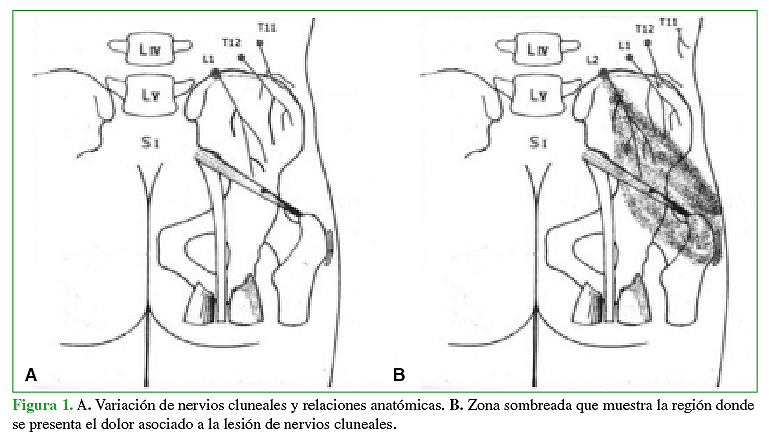Autologous donor site morbidity after posterior iliac crest bone harvest. Comparative analysis of two surgical techniques
Main Article Content
Abstract
Objectives: To compare the posterior iliac crest corticoancellous harvest using a chisel-gouge approach versus a curette approach; to evaluate intra-operative and post-operative complications; to quantify the harvested bone; to grade donor site pain.
Materials and Methods: Prospective randomized study in 34 consecutive patients for posterolateral fusion of the thoracic and lumbosacral spine; 26 women and 8 men, between 15 and 79 years of age. Subjects were divided into two groups. Group 1: curette approach; and Group 2: chisel-gouge approach. The evaluation included: the amount of bone harvested, the time required and complications.
Results: Group 1: 19 patients, 14 women and 5 men. The procedure lasted an average of 9.94min, and the harvested material averaged 9.26g. Denis Pain Scale scores at the first follow-up survey: 13 patients scored 1; 5 scored 2; 1 scored 3. Denis Pain Scale scores at the third follow-up survey: 15 patients scored 1; 2 scored 2; 1 scored 3. Group 2: 15 patients, 12 women and 3 men. The procedure lasted an average of 8.6min, and the harvested material averaged 9.26g. Denis Pain Scale scores at their first follow-up: 10 patients scored 1; 2 scored 2; 3 scored 3. At the third follow-up, all patients scored 1.
Conclusions: We observed that the posterior iliac crest graft harvested using the chisel-gouge approach is faster, provides more graft and results in less pain at 60 days.
Level of Evidence: II
Downloads
Metrics
Article Details

This work is licensed under a Creative Commons Attribution-NonCommercial-ShareAlike 4.0 International License.
Manuscript acceptance by the Journal implies the simultaneous non-submission to any other journal or publishing house. The RAAOT is under the Licencia Creative Commnos Atribución-NoComercial-Compartir Obras Derivadas Igual 4.0 Internacional (CC-BY-NC.SA 4.0) (http://creativecommons.org/licences/by-nc-sa/4.0/deed.es). Articles can be shared, copied, distributed, modified, altered, transformed into a derivative work, executed and publicly communicated, provided a) the authors and the original publication (Journal, Publisher and URL) are mentioned, b) they are not used for commercial purposes, c) the same terms of the license are maintained.
In the event that the manuscript is approved for its next publication, the authors retain the copyright and will assign to the journal the rights of publication, edition, reproduction, distribution, exhibition and communication at a national and international level in the different databases. data, repositories and portals.
It is hereby stated that the mentioned manuscript has not been published and that it is not being printed in any other national or foreign journal.
The authors hereby accept the necessary modifications, suggested by the reviewers, in order to adapt the manuscript to the style and publication rules of this Journal.
References
2. Robertson PA, Wray AC. Natural history of posterior iliac crest bone graft donation for spinal surgery. Spine (Phila Pa 1976) 2001;26(13):1473-6. https://doi.org/10.1097/00007632-200107010-00018
3. David R, Folman Y, Pikarsky I, Leitner Y, Catz A, Gepstein R. Harvesting bone graft from the posterior iliac crest
by less traumatic, midline approach. J Spinal Disord Tech 2003;(16)1:27-30.
https://doi.org/10.1097/00024720-200302000-00005
4. Delawi D, Dhert WJ, Castelein, RM, Verbout AJ, Oner FC, The incidence of donor site pain after bone graft
harvesting from the posterior iliac crest may be overestimated. Spine (Phila Pa 1976) 2007;32(17):1865-8.
https://doi.org/10.1097/BRS.0b013e318107674e
5. Ebraheim NA, Elgafy H, Xu R. Bone-graft harvesting from iliac and fibular donor sites: techniques and
complications. J Am Acad Orthop Surg 2001;9:210- 8. https://doi.org/10.5435/00124635-200105000-00007
6. Ahlmann E, Patzakis M, Roidis N, Shepherd L, Holtom P. Comparison of anterior and posterior iliac crest bone
grafts in terms of harvest-site morbidity and functional outcomes. J Bone Joint Surg Am 2002;84(5):716-20. https://doi.org/10.2106/00004623-200205000-00003
7. Sengupta DK, Truumees E, Patel CK, Kazmierczak C, Hughes B, Elders G, et al. Outcome of local bone versus
autogenous iliac crest bone graft in the instrumented posterolateral fusion of the lumbar spine. Spine (Phila Pa
1976) 2006;31:985-91. https://doi.org/10.1097/01.brs.0000215048.51237.3c
8. Gibson S, McLeod I, Wardlaw IM, Urbaniak S. Allograft versus autograft in instrumented posterolateral
lumbar spinal fusion. A randomized control trial. Spine (Phila Pa 1976) 2002;27(15):1599-603.
https://doi.org/10.1097/00007632-200208010-00002

